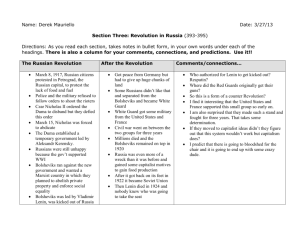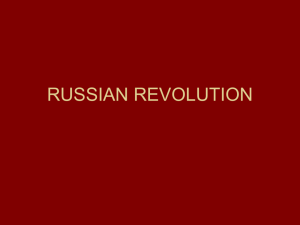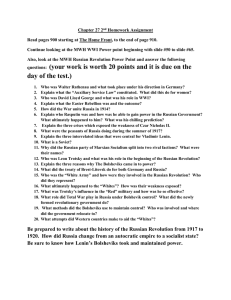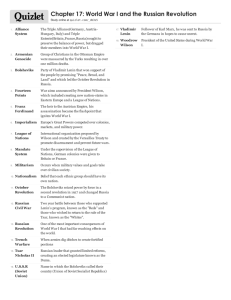Russian Revolution Screen Play
advertisement
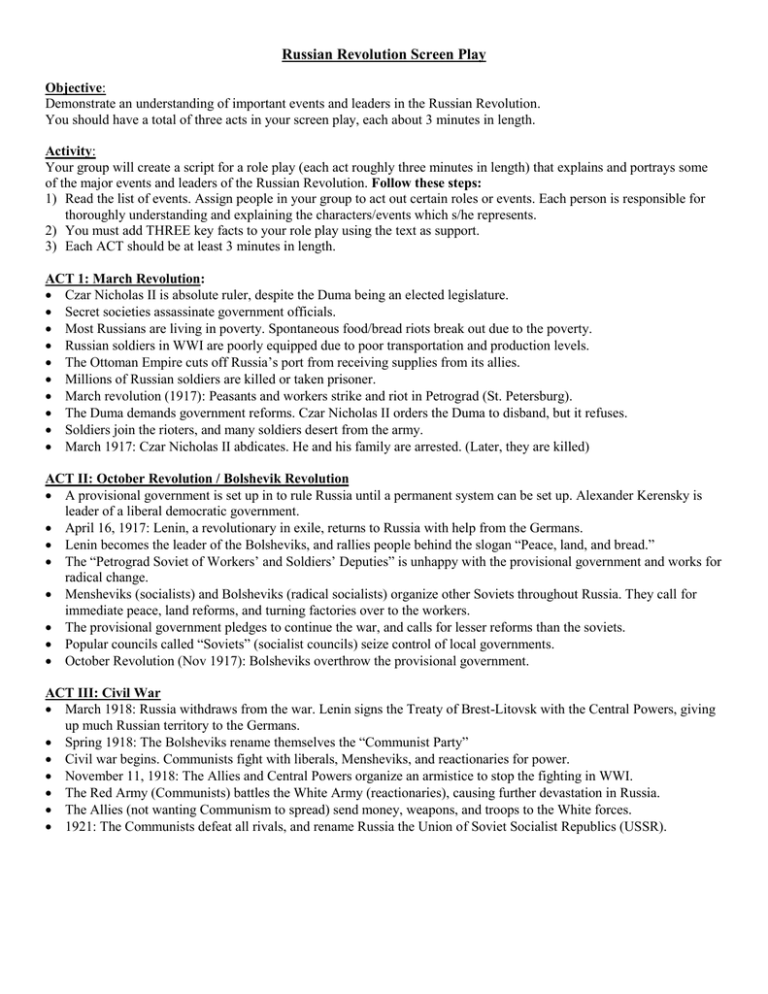
Russian Revolution Screen Play Objective: Demonstrate an understanding of important events and leaders in the Russian Revolution. You should have a total of three acts in your screen play, each about 3 minutes in length. Activity: Your group will create a script for a role play (each act roughly three minutes in length) that explains and portrays some of the major events and leaders of the Russian Revolution. Follow these steps: 1) Read the list of events. Assign people in your group to act out certain roles or events. Each person is responsible for thoroughly understanding and explaining the characters/events which s/he represents. 2) You must add THREE key facts to your role play using the text as support. 3) Each ACT should be at least 3 minutes in length. ACT 1: March Revolution: Czar Nicholas II is absolute ruler, despite the Duma being an elected legislature. Secret societies assassinate government officials. Most Russians are living in poverty. Spontaneous food/bread riots break out due to the poverty. Russian soldiers in WWI are poorly equipped due to poor transportation and production levels. The Ottoman Empire cuts off Russia’s port from receiving supplies from its allies. Millions of Russian soldiers are killed or taken prisoner. March revolution (1917): Peasants and workers strike and riot in Petrograd (St. Petersburg). The Duma demands government reforms. Czar Nicholas II orders the Duma to disband, but it refuses. Soldiers join the rioters, and many soldiers desert from the army. March 1917: Czar Nicholas II abdicates. He and his family are arrested. (Later, they are killed) ACT II: October Revolution / Bolshevik Revolution A provisional government is set up in to rule Russia until a permanent system can be set up. Alexander Kerensky is leader of a liberal democratic government. April 16, 1917: Lenin, a revolutionary in exile, returns to Russia with help from the Germans. Lenin becomes the leader of the Bolsheviks, and rallies people behind the slogan “Peace, land, and bread.” The “Petrograd Soviet of Workers’ and Soldiers’ Deputies” is unhappy with the provisional government and works for radical change. Mensheviks (socialists) and Bolsheviks (radical socialists) organize other Soviets throughout Russia. They call for immediate peace, land reforms, and turning factories over to the workers. The provisional government pledges to continue the war, and calls for lesser reforms than the soviets. Popular councils called “Soviets” (socialist councils) seize control of local governments. October Revolution (Nov 1917): Bolsheviks overthrow the provisional government. ACT III: Civil War March 1918: Russia withdraws from the war. Lenin signs the Treaty of Brest-Litovsk with the Central Powers, giving up much Russian territory to the Germans. Spring 1918: The Bolsheviks rename themselves the “Communist Party” Civil war begins. Communists fight with liberals, Mensheviks, and reactionaries for power. November 11, 1918: The Allies and Central Powers organize an armistice to stop the fighting in WWI. The Red Army (Communists) battles the White Army (reactionaries), causing further devastation in Russia. The Allies (not wanting Communism to spread) send money, weapons, and troops to the White forces. 1921: The Communists defeat all rivals, and rename Russia the Union of Soviet Socialist Republics (USSR).
